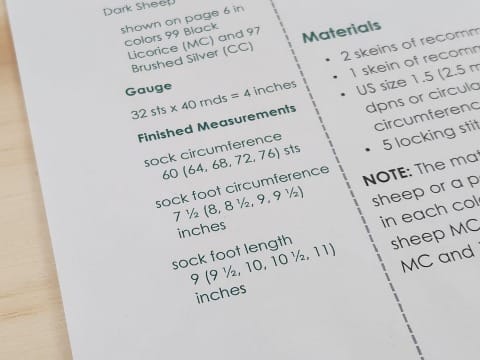Help! Which size should I knit?

Whether you're knitting a sweater, socks or even a hat, before you cast on your project, you'll need to decide which size you're going to knit. Just like the sizes in the pattern itself, there's no one-size-fits-all answer, but here are 5 important pieces of information you should consider.
Project Dimensions
All well-written patterns include the finished dimensions (after the item has been blocked, or laundered) of the project. This is a good starting point for choosing the size you want to knit. Look at the numerical dimensions, as well as the schematics to better envision the shape and proportionality of the garment.
Also, think about which project dimensions could be easy to adjust by knitting a few more rows or rounds (usually the length of something) and which dimensions would require more intense calculations for adjustments (usually the circumference or width, especially when there are increases/decreases for shaping).

Body Measurements
Knowing the size of the finished item is only part of the story. You also need to know the measurements of the body that will be wearing the finished garment.
No cheating here. This is not a measurement from times past, or what the measurements will be after exercising intensely every day for six months. Unless you're knitting something for a child who is still growing, your knitting should fit today's body.
Ease
Ease is the relationship between the finished project dimensions and your body measurements. Positive ease means the project is bigger than the body. Negative ease means the project is smaller than the body.
For example, sweaters often have positive ease. Wearing a sweater that is a little loose and moves with you rather than squeezing you at every turn feels comfortable. Socks on the other hand should have negative ease so they hug your foot, stay in place and don't slump to the bottom of your shoe.
Sometimes the recommended amount of ease is given in a pattern, but often you need to use your best judgement based on your experience with other garments, either hand knit or mass-manufactured.
The first three pieces of information - project dimensions, body measurements and ease - can be gathered without your yarn and needles. However, there's no way around it, the next two require swatching.
Fabric Hand
How much ease is needed for comfortable wear is dependent on the hand of the fabric. What does it feel like? Is it soft, firm, dense, drapey, stretchy, etc? You're going to need a finished piece of fabric to touch (i.e. a washed/blocked swatch).
The characteristics of fabric hand don't have exact numerical values assigned to them or how they relate to the amount of necessary ease. Again, you'll need to use your own experience with how the fabric feels to judge the required ease for your project.
For example, hand knit socks usually require 5-10% negative ease for a good fit. If your fabric feels very dense and doesn't have much stretch, your sock will only need to be slightly smaller than your foot to comfortably hug it all day. A tightly knit sock should have less negative ease (closer to 5%). If your fabric feels loose and stretchy, your sock will need to be much smaller than your foot to hug it in the same way. A loosely knit sock should have more negative ease (closer to 10%).
Gauge
Finally, before choosing which size you should knit, you must know your stitch and row/round gauge. Just like with your body measurements, if you want a garment to fit, there's no cheating here. Knit a swatch and don't say you always get the same pattern gauge because it's simply not true.
Remember, when you are exactly following the directions given in a pattern, your garment will only be the same size as designer's garment if your gauge is the same as the designer's gauge.
This is really important, so I'll say it another way. If your gauge is different than the pattern gauge, your garment will be a different size than what's specified in the pattern unless you make mathematical adjustments to the instructions.
For garments that fit, before you knit your next project consider the project dimensions, your body measurements, ease, fabric hand and gauge before choosing which size you'll be knitting.
There's more to explore in the Learning Library!
